So you’ve just got your PSAT practice score report from a practice test with Ashland Prep. How do you make sense of it all?
Here’s the basics:
1290 and above: you’re in the top ten to top one percent of all students. In the mid 1300s and above, you can start thinking about pushing for National Merit contention.
1000-1290: You’re in the top 50 percent to the top 89th percent of all students.
Below 1000: You’re in the 49th percentile or below.
If you’re below where you hoped you would be, do not worry! 1). This test has zero repercussions for college admissions unless you want scholarship money, which very few students obtain. 2). The actual SAT and ACT are what matter, and you have until your senior year to post your best scores on those!
The video above gives you the basics about how PSAT scoring works, as well as a synopsis of National Merit. If you want even more details, read on! Or, reach out to ravi@ashlandprep.com to get a custom analysis of your personal score report.
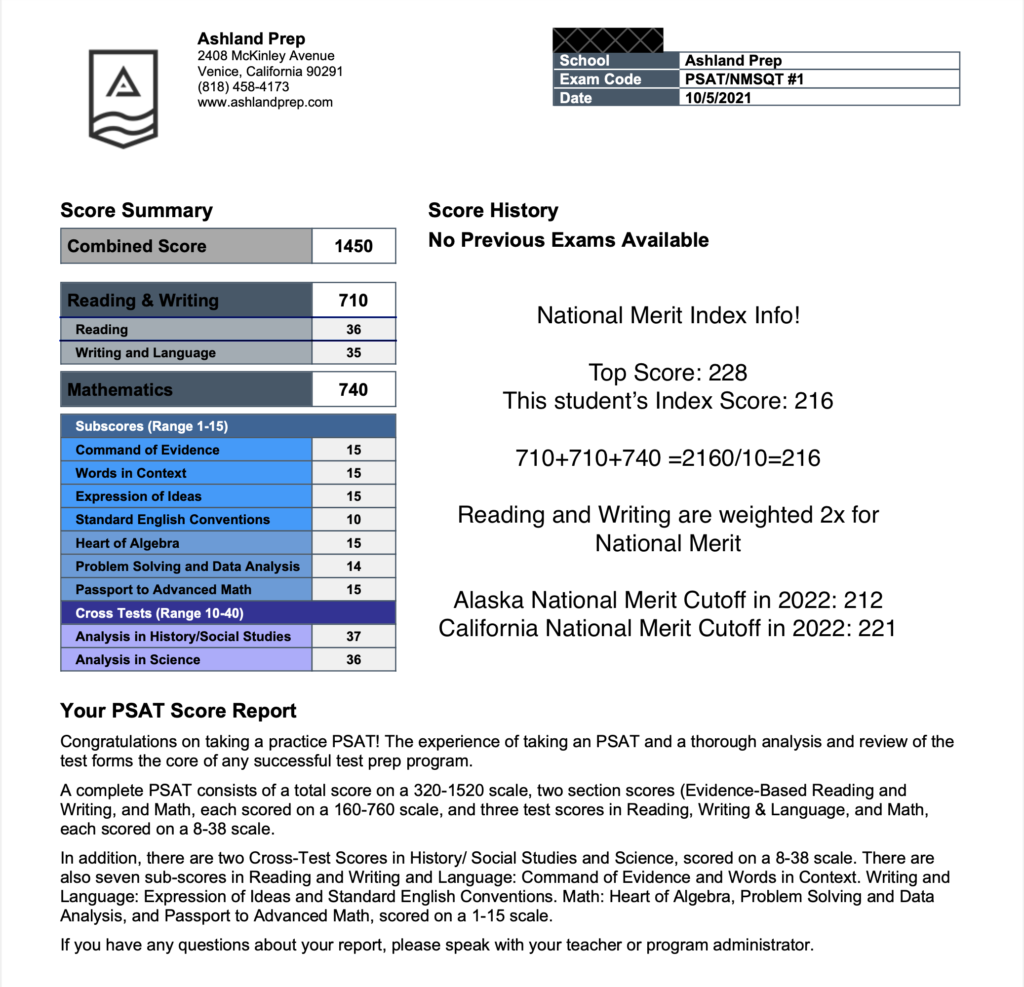
The PSAT is scored out of 1520: 760 on Reading and Writing, 760 on Math. You may remember that the PSAT’s big brother, the SAT, is out of 1600.
Why the score difference between the SAT and PSAT? This is the College Board’s way of acknowledging that the PSAT is a shorter, easier version of the SAT. Specifically, this shows that the most difficult questions on the SAT are not represented on the PSAT.
You can safely ignore the “Subscores (1-15)” section and the “Cross Tests (Range 10-40).” There’s neither significance nor insight attached to these sections. Rather, they’re jargon designed to impress high schools invested in Common Core curriculum and language. Focus on the big picture Math, Reading and Writing scores on the front page.
In Math, there are two sections: math with no calculator and math with calculator, which will be broken down later in this post. The calculator math section is longer and may be more difficult for students. This is likely because:
1). It’s longer.
2). It’s at the end of the exam when you’re super tired.
Reading and Writing is a combination of two different sections that test different things. Reading tests reading comprehension. Writing and Language tests grammar and writing fundamentals.
In this student’s case, he scored 710 out of a possible 760 on Reading and Writing, and 740 on math out of a possible 760. The total minimum score is 400. Yep — you get points just for writing your name.
To get the reading score of 710, you add up the Reading subscore of 36 to the Writing and Language subscore of 35. 36+35=71, x 10 = 710.
This student posted a strong — almost flawless — PSAT score of 1450. However, as a California resident, his score would not qualify for National Merit. If he lived in Alaska, this score would qualify for National Merit. However, what exactly is National Merit?
National Merit
In short, National Merit honors earns the winner a one-time, $2500 scholarship. That’s it. It’s great for the right student, but not worth putting hundreds of hours into achieving.
Because of it’s prestigious-sounding title and perhaps the caliber of students who achieve it, National Merit seems to have taken on a grand reputation in the admissions process amongst families. But no. Plenty of students get into top colleges without achieving National Merit honors, and plenty of students who don’t get into top colleges do earn National Merit honors.
That said, for the right type of student, they can put in 10-20 hours of work preparing for the PSAT, achieve National Merit finalist status, secure the $2500 scholarship after writing an essay, and their total ROI is in the $150-$250/hr range. That’s no joke! Furthermore, there are corporate scholarships and school scholarships attached to National Merit honors as well. Here’s the full list of participating corporations and colleges.
National Merit Index Scoring
For the student above who achieved 1450 on his PSAT practice test, he is in a situation in which the time spent studying for the PSAT could be justifiable. However, he would’ve been in a much better spot had he performed stronger on the two verbal sections rather than the math section. Here’s why:
On the PSAT National Merit Index, the top score is 228. Here’s how it breaks down:
PSAT Reading and Writing top score: 760
PSAT Math top score: 760
Multiply the Reading and Writing top score by 2: 1620
Add the PSAT math top score: 1620+760= 2280
Divide all by 10: 228.
Now, let’s take the student above, who has 216 as his composite score:
710 Reading and Language score
710×2 -=1420
+ 740
=2160
Divide 2160 by 10
216.
A National Merit index score of 216 would be great for Alaska, but not California. Generally, rural, less populated states have lower National Merit cutoff standards than populous, coastal states. This student happens to be from California, where the cutoff in 2022 was 221 in 2022. Still, his practice PSAT scores are close enough to National Merit honors to make the scholarship worth studying for. Below, I’ll break down each of the student’s sections and show you why.
Sections 1 and 2: Reading and Writing
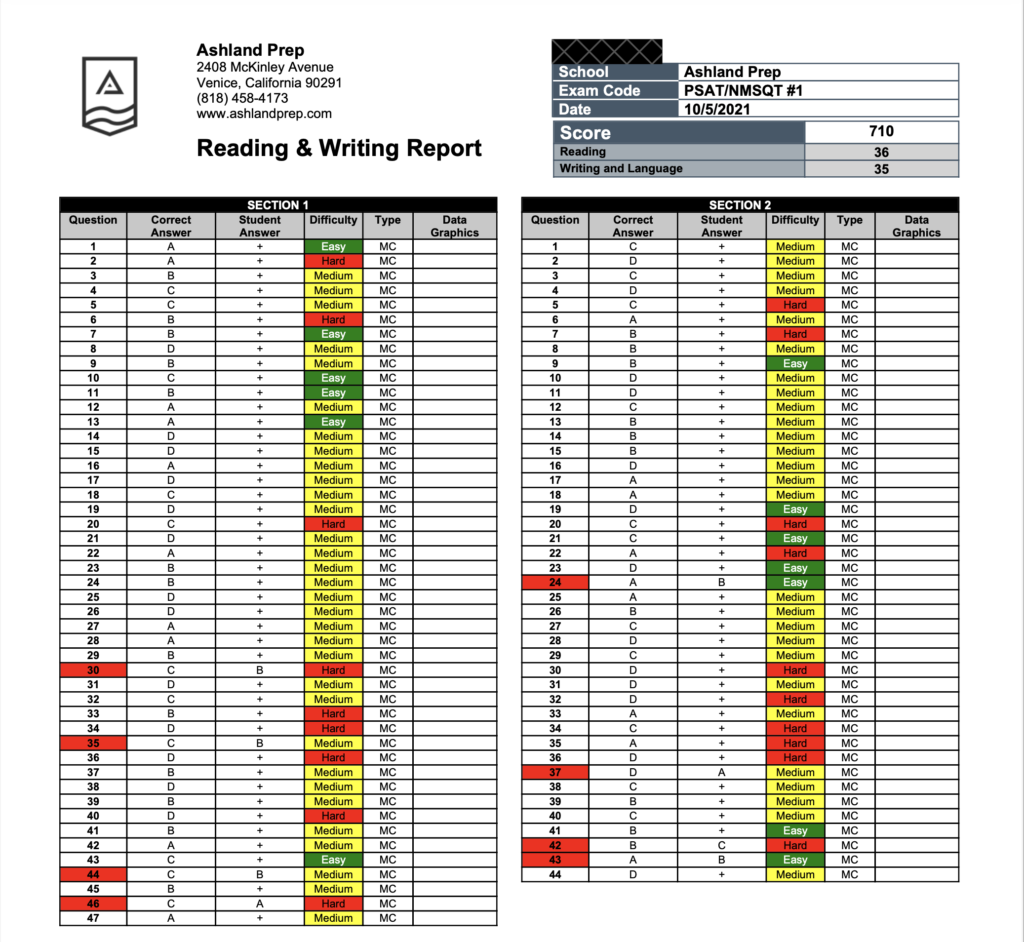
The pages above show a breakdown of the questions this student got right and wrong. Red = incorrect. As you can see, this student tested with excellent accuracy. As a tutor, I notice that he seems to lose some focus at the end of both sections. If he decides he needs tutoring with us, we would review some stamina-building techniques, which may potentially help more than actually reviewing individual content areas he missed.
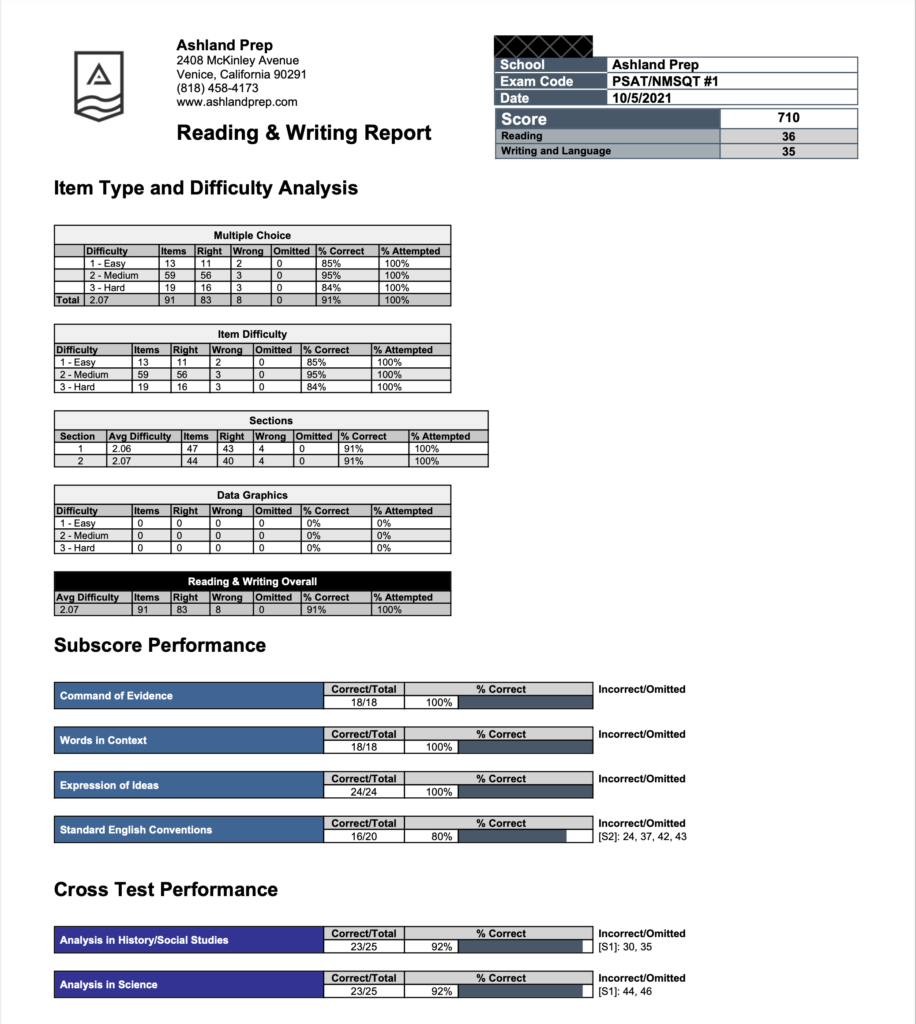
The third page of this score report above summarizes how this student performed across easy, medium and hard questions. Of all the data, I personally love the summary of easy, medium, and hard questions at the top of the page. For many students, this page can help them gain more confidence in their testing ability. For instance, this student here got two easy questions wrong. While we’d have to dig deeper into the test to figure out why, chances are really good he has the ability to make simple corrections to his approach and get those easier questions right.
How do I know this?
Logic: if a student can get the majority of medium and hard problems right, as demonstrated above, there’s no reason to get ANY of the easy questions wrong.
Had this student gotten those two easy questions right, chances are very strong his score on Reading and Writing would have bumped up to 730. This would bring his overall Index score to 220. By getting all the mediums and the easy questions right and missing the same amount of hard questions, this student would have exceeded the California cutoff for National Merit honors.
Math Section 3, No Calculator and Math Section 4, Calculator
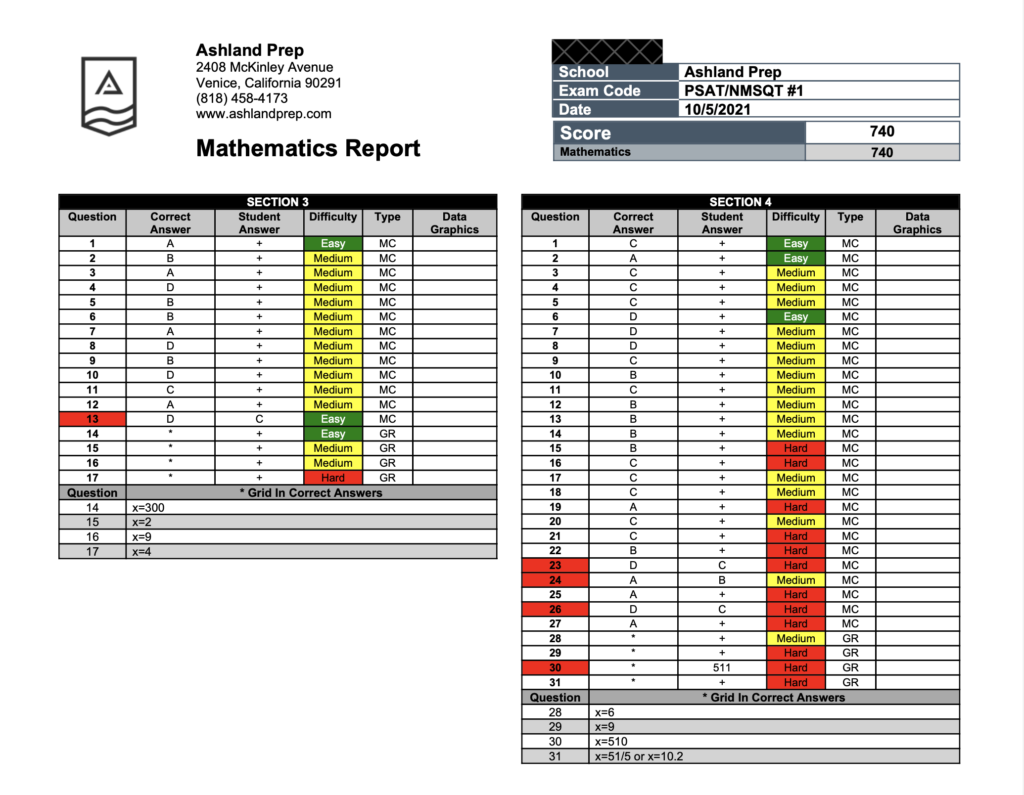
The page above breaks down each of the math sections. Like on the SAT, the Math section with no calculator comes first, followed by Math with Calculator. Here, this student demonstrates the ability to be consistent on easy and medium problems, but struggles with some of the harder problems at the end of the math test.
Interestingly, the curve on this particular math section was favorable to the student here. Five questions wrong doesn’t normally yield only 20 points off a perfect math score. This suggests that there is indeed an element of luck to obtaining National Merit and high PSAT scores. If I were talking to this student’s parents, I would ensure they were aware that their student’s raw math score would likely yield lower results on the real PSAT.
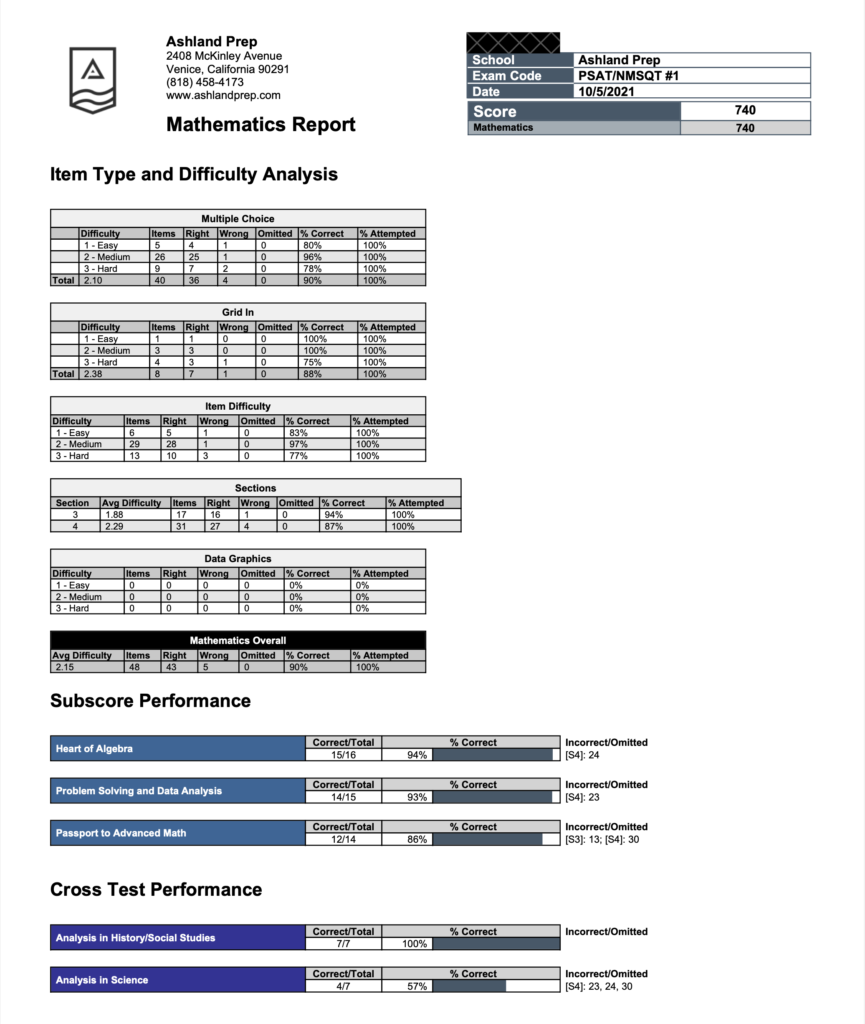
Unlike the Reading and Writing sections, this question difficulty breakdown suggests that there’s very little “low hanging fruit” for him to exploit on the math sections. Three of his five incorrect questions are hard. In working with this student, we would primarily spend time assessing the incorrect math problems, but really spend the majority of our time on Reading and Writing.
Why?
1). This student has more “low hanging fruit” in the Reading and Writing sections: easy and medium questions that he should be able to get right with minor tweaks in knowledge or strategy.
2). On the PSAT, the Reading and Writing section is weighted more than math, so any points gained will be worth more overall.
In this post, we did the following:
1). Gained a basic understanding of the National Merit process.
2). Broke down this individual student’s score report by section.
3). Used the data to show why he’s capable of a National Merit finalist score with the correct strategy and approach.
If you’d like an analysis like this of your score report, please reach out to ravi@ashlandprep.com. This student likely needs to develop consistent habits over the course of four sections to achieve his top score, rather than harping on individual question types. Your score report may tell us something different. We’d be happy to help!
Until next time,
Ravi
Ashland Prep